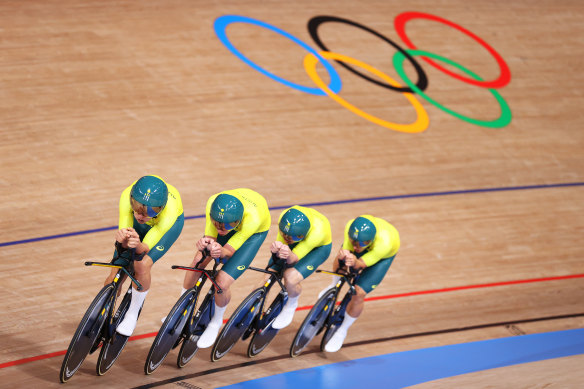The war on air: The tactics of team track cycling
In the high-octane world of Olympic track cycling, where milliseconds separate glory from obscurity, the invisible enemy is the air.
At speeds exceeding 60 kilometres per hour, the cyclists face a formidable foe: drag force. This aerodynamic resistance increases with velocity, stealing precious energy from even the most powerful athletes.

Australia’s team pursuit riders hit the track at the Tokyo Olympics.Credit: Getty Images
To combat this invisible adversary, teams employ cutting-edge science and meticulous strategy. Wind tunnel testing has become a crucial tool in the cyclist’s arsenal. Engineers and mathematicians scrutinise data to optimise both bicycle design and rider positioning.
The ideal posture — a low, tucked position with the head tilted down and arms together in front — allows air to flow more efficiently over the rider, minimising drag and maximising speed.
Tactics in the team pursuit
In the team pursuit and team sprint events, which the Australian team will be targeting for medals, aerodynamics takes on an even more critical role.
The team pursuit, a gruelling four-kilometre race between two four-rider teams, showcases the intricate balance between power and precision.
Riders must maintain an incredibly close formation – often with only centimetres separating the wheels of the riders – with each taking turns at the front to shelter their teammates from the brunt of the oncoming air.
The lead cyclist typically accelerates slightly faster at the start, establishing the front position for the initial laps. Subsequent position changes require exquisite timing and skill. Riders swing high on the track around bends before swooping down to seamlessly rejoin the rear of the formation.
At the speeds they are travelling, even small errors in execution can increase drag enough to jeopardise a rider’s ability to maintain contact with the group. The other riders then have more work to do, since they have to drive the front of the train more often.
Some teams may employ strategic dropping, where a rider takes an extended turn at the front before deliberately falling away. This tactic can be advantageous as the rider shelters their teammates from the oncoming air before peeling off to let them through.
Since the team’s time is recorded when the third rider crosses the finish line, one rider’s sacrifice can secure success for the rest of the team.
Tactics in the team sprint
The three-rider team sprint event is a shorter, faster version of the team pursuit. Contested over a shorter 750-metre distance, it demands even greater precision in their formation due to the higher speeds involved.
Despite the similarity, tactics can be very different.
The lead rider often accelerates so rapidly that a small gap forms to the second cyclist. This gap, carefully calculated, allows the second rider to utilise the lead rider’s slipstream for a slingshot effect at the end of the first lap.
Timing in this manoeuvre is critical. If the gap is too large, the second rider won’t catch the leader at the optimal moment at the end of the first lap, wasting valuable time. Conversely, if the gap is insufficient, the second rider must decelerate, negating the potential slingshot advantage.
With races often decided by thousandths of a second, perfecting this technique can mean the difference between silver and gold. Executed poorly, a podium finish is impossible.
The final rider in the team sprint faces a unique challenge, tasked with maintaining maximum velocity for the entire 750-metre distance while battling intense fatigue.
For this rider, it’s more a war of attrition than a short sprint. The rider who can maintain their speed the best as their legs scream to stop stands the best chance of helping their team to victory.
The complete package
As the Olympic track cycling events unfold, spectators will witness the culmination of years of high-level training, scientific research, wind tunnel testing and precise tactical planning.
The Australian team’s success will hinge not just on raw power and endurance, but on their ability to harness the principles of aerodynamics to slice through the air with minimal resistance.
In the end, as our cyclists push themselves to the limit in pursuit of Olympic glory, they won’t just be racing against their competitors — they’ll engage in a battle against the very air they breathe.
The teams that win the air war stand the best chance to win gold.
News, results and expert analysis from the weekend of sport sent every Monday. Sign up for our Sport newsletter.